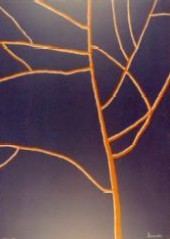
- titled: lower left, in pencil
- signed: lower right, in pencil; numbered lower left, in
pencil; printer's chop lower right corner
- medium: two-color serigraph; printed by Robert Dressen
and Jeff Wasserman at Wasserman Silkscreen, Santa Monica,
California
- dimensions: bleed image - sheet and image size: 30 x 22"
(76.2 x 55.9 cm.)
- edition: 150 prints, 15 artist's proofs, 1 color trial
proof, 3 printer's proofs, 1 publication proof; all on Stonehenge
paper
- date published: 1979
Personal Reflections, by Arthur Secunda
Acacia, as a serigraph, evolved from a collage of the
same name that I did at one of the happiest and most creatively
exhilarating times of my life. The year was 1976 and I was living
on the "wrong side of the tracks" in Arles, Southern France, in a
small isolated house not far from the railroad station. This was
one of the most fertile periods of my life: I used to rise at 4
a.m. every day and explore all the nooks and crannies of this
wondrous Roman town with its mysterious light and quirky provencal
populace. In the summer months the heat was so heavy ("il fait
lourd," they-would say) that by noon it was too hot to move around
much as the air would sap all one's energy. The first time I went
to Arles, many years earlier, I was amazed at how many of the
locals would sit in the shade every summer afternoon and seemingly
stare into space. Later I found myself doing the same
thing - accomplishing my paper-tearing in the wee hours of the cool
morning, and finding sedative activities in the afternoon.
There was a fragile acacia in our yard at the time, which
captivated my attention for all the negative spaces between its
branches. Sometimes the sky was so blue you could virtually taste
it. The collage was effected by literally tearing out the negative
spaces while grasping red and blue papers, then affixing them
slightly off-register to obtain a relief or 3 dimensional effect.
I had used this device many times before, as in the lithograph,
Entrance to Infinity, at Landfall Press in Chicago.
In 1979, returning to Los Angeles, I printed the serigraph,
Acacia, at the tiny garage workshop-studio of Jeff Wasserman
in an alley off 14th Street near Pico Boulevard in Santa Monica.
Jeff, who is now regarded as one of the top silkscreen printers in
the United States, has printed dozens of editions of my graphics
and assisted with monotypes as well as sculpture-fabricating
projects since then. It was Zora Pinney, of Zora's Gallery in
Brentwood, who told me about him. Zora was one of the most dynamic
catalysts in the Los Angeles art world of the late 50s and early
60s, bringing artists together from Mexico, New York and
elsewhere.
Some years later, I was still obsessed with those negative
spaces, and did a painting called Acacia, using the
structure of the original collage as a basis for a sort of
stained-glass surface, with different textures and exotic materials
such as polyester, poured in the "holes" between the contoured
strips. In this way, I felt I was opening up, or pushing and
spreading those areas to give them a more spacious dimension in
which to exist. Hence the original collage became a kind of matrix
idea from which I could generate variations in different media and,
to use a musical metaphor, in other keys and tonalities.
|




